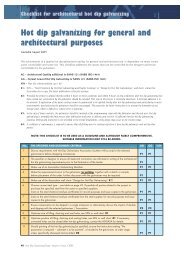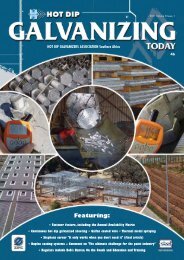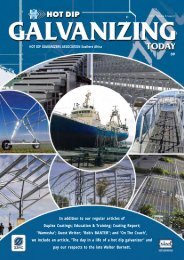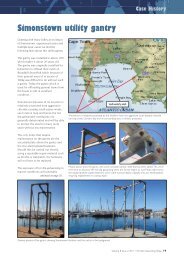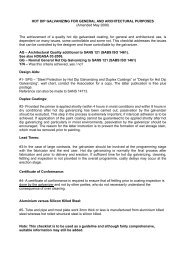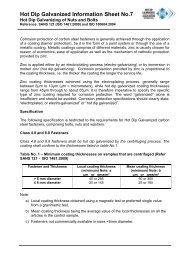Featuring: - hdgasa
Featuring: - hdgasa
Featuring: - hdgasa
Create successful ePaper yourself
Turn your PDF publications into a flip-book with our unique Google optimized e-Paper software.
Duplex Coatings<br />
* Select an ISO 12944 compliant system EN ISO 12944-5:1998<br />
Table A9: Paint systems corrosivity categories C2 to C5-I and C5-M<br />
Substrate: Hot dip galvanized steel<br />
The paint systems given in the following table are only examples. Other paint systems having the same performance are possible.<br />
If these examples are used, it shall be ensured that the paint systems chosen comply with the indicated durability when execution of the paint work takes place as specified. See also 5.7.<br />
Paint Priming coat(s) Top coat(s) including Paint system Expected durability 2)6) (see 5.5 and ISO 12944-1)<br />
System No<br />
intermediate coat(s)<br />
Binder5) Number NDFT 3µm Binder5) Number NDFT 3µm Number Total C2 C3 C4 C5-I C5-M<br />
of coats of coats of coats NDFT 3)µm L M H L M H L M H L M H L M H<br />
S9.01 – – 1 80 1 80<br />
S9.02<br />
PVC<br />
1 40<br />
PVC<br />
1 80 2 120<br />
S9.03<br />
1 80<br />
1 80 2 160<br />
S9.04 1 80 2 160 3 240<br />
S9.05 – – 1 80 1 80<br />
S9.06<br />
AY<br />
1 40 1 80 2 120<br />
S9.07<br />
1 80 AY 1 80 2 160<br />
S9.08 1 80 2 160 3 240<br />
S9.09 – – 1 80 1 80<br />
S9.10 EP 1 40 EP 1 80 2 120<br />
S9.11 or 1 80 or 1 80 2 160<br />
S9.12 PUR 1 80 PUR 4) 2 160 3 240<br />
S9.13 1 80 2-3 240 3-4 320<br />
Binders for priming coat(s) Paints (liquid) Binders for top coat(s) Paints (liquid)<br />
No of components Water borne No. of components Water borne<br />
1-pack 2-pack possible 1-pack 2-pack possible<br />
PVC = Polyvinyl chloride x PVC = Polyvinyl chloride x<br />
AY = Acrylic x x AY = Acrylic x x<br />
EP = Epoxy x x EP = Epoxy x x<br />
PUR = Polyurethane x PUR = Polyurethane x x<br />
FOR FURTHER INFORMATION CONTACT THE ASSOCIATION<br />
Table A.9<br />
climatic factors during application of<br />
coating and possible combinations of<br />
these parameters before, during and<br />
after application.<br />
Duplex systems have been shown to<br />
have relatively high R values when<br />
compared with paint systems (applied<br />
on blasted or hand brushed steel<br />
surfaces) and with hot dip galvanizing.”<br />
See reliability factor table on page 31.<br />
The use of Duplex Systems is manifold,<br />
both for extending the durable life of<br />
hot dip galvanized items, and for<br />
improved aesthetics in all types of<br />
corrosion environments (refer ISO<br />
Big Ben in London with one of its 100-year-old<br />
galvanized and later painted tiles in the<br />
foreground.<br />
12944 atmosphere corrosivity<br />
categories and typical environments<br />
table, also ISO 9223).<br />
If at the end of a long period of<br />
protection, maintenance painting has<br />
to take place, the absence of rust<br />
permits maintenance painting without<br />
having to rely on dusty abrasive<br />
blasting and cleaning procedures (only<br />
a weathered zinc alloy remains).<br />
The history of Duplex Systems is<br />
difficult to trace in detail, however it is<br />
evident that it was used approximately<br />
113 years ago on cast iron roof tiles on<br />
London’s Big Ben clock. These tiles<br />
were Hot Dip Galvanized and later<br />
painted and are still in sound condition<br />
today (see left). See also other photos in this<br />
article.<br />
The five basic functions of<br />
duplex systems<br />
1) By covering the reactive Zinc<br />
surface exposed to aggressive<br />
climates such as industrial marine,<br />
urban or combinations thereof, the<br />
speed of corrosion of the Zinc is<br />
drastically reduced because of<br />
oxidation attack by the moisture,<br />
and attack by a combination of<br />
Sulphur and chloride compounds,<br />
nitrogen oxides and ammonia are<br />
prevented by the organic paint<br />
system. (The paint coating<br />
supports the hot dip galvanized<br />
coating and prevents premature<br />
oxidation, on the other hand hot<br />
dip galvanized coatings (alloyed to<br />
the steel surface) will prevent the<br />
formation of rust on the steel).<br />
2) Improvement of the aesthetic<br />
appearance of the Hot Dip<br />
Galvanizing (eg balconies,<br />
staircases, railings, fences, lamps<br />
poles, buildings etc).<br />
3) Objects are often required to have<br />
contrasting colours in order to<br />
enhance visibility for traffic safety<br />
roads signs, towers near airports,<br />
microwave towers, beacons, light<br />
houses, cranes, busses, rolling<br />
stock, scaffolding, garden furniture<br />
etc).<br />
4) In contrast to (3) it may be<br />
necessary to camouflage objects eg.<br />
transmission towers, light poles<br />
and military installations to make<br />
the appearance less obvious and<br />
blend in with the environment<br />
5) Duplex Systems can be used to<br />
assist when objects require a very<br />
long duration of protection<br />
because:<br />
a) Surfaces are inaccessible for<br />
coating maintenance. (ie mine<br />
shaft structures)<br />
b) Interruption of plant process is<br />
not convenient. (Down time<br />
costs)<br />
c) Contamination of goods and<br />
products are inadmissible.<br />
The principal advantages of<br />
duplex coatings<br />
Avoidance of under creep rust, thus<br />
preventing premature destruction of<br />
paint – coating through voluminous<br />
rust.<br />
1. Sealing of pores and small<br />
damaged areas are sealed by<br />
formation of insoluble zinc salts.<br />
Australian Plaza, near the Pacific beach, with<br />
purlins and glazing frames protected by a<br />
duplex system based on polyurethane.<br />
32 Hot Dip Galvanizing Today Volume 4 Issue 3 2007



